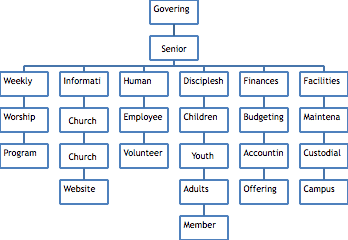There are many responsibilities that come with managing a church and countless tasks that need to be done. Counting the donations, managing volunteers, setting up service, planning the worship, turning on the lights, cleaning the facility, locking the doors, and the list goes on and on. Wearing all of these hats can be overwhelming! So how do you organize it all?
What Does an Organizational Chart Look Like For a New Church? A Guide for Church Planters
Many churches use organizational charts to show a picture of the key functions, reporting structure and relationships. As they say, a picture speaks a thousand words and can communicate order.
The way you organize your church depends greatly on the governance model you create. Some churches are pastor-led; some are board-led; and some are congregational-led. The chosen governance model will dictate its structure.
An important aspect of church governance is having an active board that oversees the fulfillment of the church mission. This is done by developing strategy, financial oversight, monitoring risk and ensuring legal compliance – while adhering to established church bylaws.
New churches have all of the same needs as established churches (volunteer support, music, production, facility, finance) but often lack the resources that are available to more established churches. Nonetheless, it is important for a church plant to establish its structure, so that as it grows, there will be a natural placement of resources as they become available.
There are six key functions of a church. Each one is important in its own way. If your church can organize around these key areas, you will have a foundation from which you can designate resources (people, time and money) as they become available.
Many of these areas will be manned by volunteers necessitating the development of a core volunteer leadership group. From that leadership group you can commission committees to help plan and implement the work in each area.
The six areas are:
- Church Services
- Discipleship
- Facilities
- Human Resources
- Information Technology
- Finances
1. Church Services
Successful church services are the result of thoughtful planning, dedicated volunteers and technology to support the plan. Planning encompasses the worship and program that is used to illustrate the sermon message. This is done with the support of an audio visual system that is manned by trained volunteers.
2. Discipleship and Member Care
A church is only as effective as its ability to develop its members into mature Christians. This necessitates the planning and oversight of programs that support the spiritual development of children, youth and adult church members. These program developments are in addition to supporting and caring for members during those inevitable difficult times of life.
3. Church Facilities
A church is technically a group of people. However, those people need a place to assemble, fellowship and grow in the word of God. Church buildings are where this happens. Whether the church is renting a neighborhood school, store front or a traditional church building, caring for that facility requires ongoing maintenance and custodial support.
Large or small, the facility facet of a church is an important part of creating a welcoming environment for members and visitors. And, someone(s) needs to be responsible for the maintenance and upkeep of the facility.
4. Human Resources
Churches would not exist without the army of people who commit to supporting its mission. Many of these people work in a volunteer capacity, but some are hired as paid employees. There are many complexities that come with managing volunteers and employees. These complexities make it necessary to create systems and processes to support those people – whether they provide free or paid labor.
5. Information Technology
We have all become accustomed to using technology in all aspects of our lives. And, the church is no different. Churches need to have technology to support what it is trying to do: a relevant website, computers, mobile devices, complex phone systems, sound systems and equipment that support weekly services. The IT team is charged with ensuring the church has the technology needed to do what it does as well as the needed support for technical failures.
6. Finances
Churches survive off of the generous tithes of its members. And, the church is responsible for the proper stewardship of those resources. That responsibility requires the development of financial infrastructures that support cash handling protocol, budgeting and general financial oversight. This team is charged with ensuring that the money that is donated to the church is used for its intended purposes and that there are adequate resources available to support the church mission.
This is an example of what an organizational chart might look like. As you can see, the governing board is at the top, followed by the pastor. This is merely an example, so if your church is structured a little differently, that’s ok.
As you can see, each of the six areas is listed under the pastor. The idea in this model is that the pastor works with the leadership team to help them determine the best strategy and approach for each area.
For example, the pastor may share his thoughts on what kind of support he needs during a church service; or he may have ideas on how to structure a youth program. The goal would be for him to share his thoughts and the leader over the area manages the process from there.
This type of team approach is a great way to take advantage of the wealth of experiences of others and share the responsibilities to get things done.
There is a saying, “many hands make light work” and there is no truer statement in the church. Organizing systems and processes to share the load is what organizational structures are made for. Developing a structure can help provide organization and operational order to fulfilling your church mission.
As you consider ways to make your ministry purposeful and effective, check out these 50 Bible verses about leadership for guidance.


